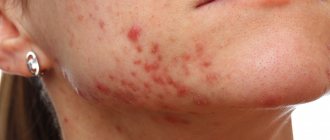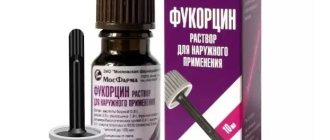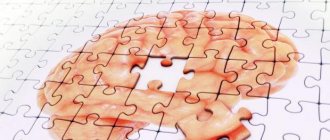About Haloperidol
International name:
Haloperidol Synonyms: Halofen, Aloperidin, Haldol, Halidol, Haloperidin, Haloperin, Halophen, Halopidol, Serenace, Seranase, Haloper, Novo Peridol, Senorm
Group affiliation:
Neuroleptic (antipsychotic)
Description of the active substance (INN): 4- (para Chlorophenyl) - 1 [3′- (para-fluorobenzoyl)-propyl]-piperidinol-4, or 4-[4-(para-chlorophenyl)-4-hydroxypiperidino] -4 ′-fluorobutyrophenone.
Dosage form: tablets for oral administration, 0.0005 g; 0.001 g; 0.0015 g; 0.002 g; 0.0025 g; 0.005 g and 0.01; injection solution 0.5%; oral solution in the form of drops containing 0.002 g of active substance in 1 ml (10 drops contain 1 mg of haloperidol); a solution of haloperidol decanoate, the injection of which provides a therapeutic effect lasting about 4 weeks.
Pharmachologic effect:
Antipsychotic drug (neuroleptic), butyrophenone derivative. Due to the blockade of depolarization or reduction of the degree of excitation of dopamine neurons and blockade of postsynaptic dopamine D2 receptors in the mesolimbic and mesocortical structures of the brain, it has a pronounced antipsychotic effect.
Due to the blockade of α-adrenergic receptors of the reticular formation of the brain stem, it has a moderate sedative effect. Thus, it eliminates delusions, manic states, hallucinations, and persistent personality changes. It also has a pronounced antiemetic effect (due to the blockade of dopamine D2 receptors in the trigger zone of the vomiting center). Affects autonomic functions (reduces the tone of hollow organs, motility and secretion of the gastrointestinal tract, eliminates vascular spasms) in diseases accompanied by agitation, anxiety, and fear of death. Effective in patients resistant to other antipsychotics. Unlike aminazine, it does not cause lethargy and apathy in patients; on the contrary, it has an activating effect. In hyperactive children, it eliminates excessive motor activity and behavioral disorders (impulsivity, aggressiveness, difficulty concentrating).
Indications:
Acute and chronic psychotic disorders (including schizophrenia, manic-depressive, epileptic, alcoholic psychoses), psychomotor agitation of various origins (mania, dementia, mental retardation, schizophrenia, chronic alcoholism), delusions and hallucinations (paranoid states, acute psychosis ), mental retardation, agitated depression, Tourette's disease, Gettington's chorea, behavioral disorders in children (including hyperreactivity and childhood autism) and the elderly, stuttering, psychosomatic disorders.
Also used for indomitable vomiting (including during chemotherapy for the prevention and treatment of nausea and vomiting), long-lasting and treatment-resistant hiccups.
In small doses (up to 10 mg) it is indicated in the treatment of reactive conditions and neuroses.
In the case of alcoholic delirium with visual hallucinations, under the influence of haloperidol, psychomotor agitation quickly decreases and hallucinations disappear.
Can be used in combination with sleeping pills, analgesics and other neurotropic drugs in preparation for operations.
It is also known that haloperidol is effective for relieving pain, agitation, nausea and vomiting in acute coronary insufficiency (usually together with analgesics).
Contraindications:
Hypersensitivity to the drug (including other butyrophenone derivatives, sesame oil), for intramuscular and intravenous injections - children under 3 years of age, diseases of the central nervous system accompanied by pyramidal and extrapyramidal symptoms (including Parkinson's disease), depression , comas of various origins, hysteria, severe depression of central nervous system function due to intoxication with xenobiotics.
Haloperidol is strictly contraindicated during pregnancy and breastfeeding. The toxic effect on the fetus and disruption of its development have been experimentally proven. It has also been established that haloperidol is excreted in breast milk (in this case, a sedative effect and impaired motor functions are detected in a child during breastfeeding).
In case of development of tardive dyskinesia (the occurrence of such phenomena as protruding the tongue, smacking lips, puffing out the cheeks, sucking, chewing, swallowing movements, grimacing, breathing problems, rolling eyes, obsessive stereotypical movements of the limbs, head), it is necessary to gradually reduce the dose of haloperidol and prescribe another a drug.
Haloperidol is prescribed with great caution for diseases of the cardiovascular system with symptoms of decompensation, conduction disorders of the heart muscle (including angina, prolongation of the QT interval on the ECG or a predisposition to this, hypokalemia, simultaneous use of other drugs that can cause prolongation of the interval QT) and kidney function.
Haloperidol is used to a limited extent for epilepsy, liver and/or renal failure, thyrotoxicosis, pulmonary-cardiac and respiratory failure (including chronic obstructive pulmonary disease and acute infectious diseases), prostatic hyperplasia with urinary retention, alcoholism, and closed-angle glaucoma.
There are reports of the possibility of the appearance of symptoms of diabetes insipidus during haloperidol therapy, and a tendency (with long-term treatment) to the development of lymphomonocytosis.
Elderly patients usually require a lower initial dose and a more gradual dose titration due to the high likelihood of developing extrapyramidal disorders. Careful monitoring of the patient is important. During treatment with haloperidol, it is necessary to stop drinking alcohol, and you should also refrain from engaging in potentially hazardous activities that require increased attention and high speed of psychomotor reactions (including driving vehicles).
Side effects:
From the side of the central nervous system: headache, insomnia or drowsiness (especially at the beginning of treatment), a state of restlessness, anxiety, fear, excitement, euphoria or depression, restlessness, epileptic attacks, paradoxical reaction (exacerbation of psychosis, hallucinations). With long-term treatment, extrapyramidal disorders may appear: tardive dyskinesia (smacking and wrinkling of lips, puffing out of cheeks, rapid and worm-like movements of the tongue, uncontrolled chewing movements, uncontrolled movements of the limbs); tardive dystonia (frequent blinking, eyelid spasms, unusual facial expressions, grimacing, unusual body position, uncontrolled bending movements of the neck, torso, arms and legs); neuroleptic malignant syndrome (difficulty or rapid breathing, rapid heartbeat, heart rhythm disturbances, fever, increased or decreased blood pressure, increased sweating, urinary incontinence, muscle rigidity, epileptic seizures, loss of consciousness).
From the cardiovascular system: when using high doses - decreased blood pressure, orthostatic hypotension, heart rhythm disturbances, increased heart rate, ECG changes (prolongation of the QT interval, signs of ventricular flutter and fibrillation).
From the gastrointestinal tract: when using high doses - dry mouth, difficulty salivating, loss of appetite, nausea, vomiting, constipation or diarrhea, impaired liver function up to jaundice.
From the endocrine system: gynecomastia, pain in the mammary glands, increased levels of prolactin in the blood, menstrual irregularities, decreased potency, increased libido, priapism.
From the genitourinary system: urinary retention (with prostatic hyperplasia), peripheral edema.
Metabolism: increased or decreased blood glucose levels, decreased sodium levels in the blood, sweating, increased body weight.
From the hematopoietic system: rarely - mild and temporary leukopenia, leukocytosis, agranulocytosis, slight erythropenia, tendency to monocytosis.
On the part of the visual organs: cataracts, retinopathy, blurred vision, accommodation disturbances.
Allergic reactions: rarely - skin rash, spasm of the bronchi, larynx. Dermatological reactions: maculopapular and acne-like skin changes; rarely - photosensitivity, alopecia.
Overdose:
Symptoms: severe extrapyramidal disorders (tardive dyskinesia, tardive dystonia, neuroleptic syndrome), drop in blood pressure, drowsiness, lethargy, in severe cases - coma, respiratory depression, shock. Treatment: there is no specific antidote. In case of overdose caused by oral administration of the drug, it is necessary to perform gastric lavage, followed by the administration of activated carbon. In case of respiratory depression - carrying out measures for artificial ventilation of the lungs, with a pronounced decrease in blood pressure - the introduction of plasma-substituting fluids, plasma, norepinephrine (but not adrenaline!), to reduce the severity of extrapyramidal disorders - central anticholinergic blockers and antiparkinsonian drugs.
Directions for use and dosage:
Haloperidol is taken orally, during or after meals, with a full (240 ml) glass of water or milk, the initial dose for adults is 0.5-5 mg 2-3 times a day. If necessary, the dose is gradually increased until the desired therapeutic effect is achieved (on average - up to 10-15 mg, in chronic forms of schizophrenia - up to 20-60 mg). The maximum dose is 100 mg/day. Duration of treatment is 2-3 months. Reduce the dose slowly, maintenance doses are 5-10 mg/day. Elderly or weakened patients at the beginning of treatment are prescribed orally, 0.5-2 mg 2-3 times a day. Children 3-12 years old (or weighing 15-40 kg) with psychotic disorders - orally, 0.05 mg/kg/day in 2-3 divided doses; if necessary, taking into account tolerability, the dose is increased by 0.5 mg 1 time over 5-7 days to a total dose of 0.15 mg/kg/day. For non-psychotic behavioral disorders, Tourette's disease - orally, initially 0.05 mg/kg/day in 2-3 divided doses, then the dose is increased by 0.5 mg once every 5-7 days to 0.075 mg/kg/day. For childhood autism - orally, 0.025-0.05 mg/kg/day. If there is no effect within 1 month. It is not recommended to continue treatment.
Haloperidol drops are taken with meals, dosed with a teaspoon, added to drinks or food, or on a lump of sugar (except for diabetics).
At the beginning of treatment, adults and adolescents usually take 0.5-1.5 mg of haloperidol 2-3 times a day (initial daily dose 0.5-5 mg). Then the dose is gradually increased by 0.5-2 mg per day (in resistant cases by 2-4 mg per day) until the required therapeutic effect is achieved. When relieving acute symptoms in a hospital setting, the initial daily dose may be increased to 15 mg of haloperidol, and higher in therapeutically resistant cases.
On average, the therapeutic dose is usually 10-15 mg/day, in chronic forms of schizophrenia - 20-40 mg/day, in resistant cases - up to 50-60 mg/day. Maintenance doses (outside exacerbations) in outpatient settings can range from 0.5 to 5.0 mg/day.
In acute conditions and in cases where oral administration is not possible, intramuscular or intravenous injections are used. For “uncontrollable” vomiting - 1.5-2 mg 2 times a day. The average single dose for intramuscular administration is 2-5 mg, the interval between injections is 4-8 hours. For acute psychoses - 5-10 mg intravenously or intramuscularly. The indicated dose can be re-administered 1-2 times at intervals of 30-40 minutes until the desired effect is obtained. The maximum daily dose is 100 mg. For acute alcoholic psychosis - 5-10 mg intravenously; if ineffective, an additional infusion of 10-20 mg is performed at a rate of no more than 10 mg/min. An injection solution containing haloperidol decanoate, strictly intramuscularly, 25 mg every 15-30 days, if necessary, the dose can be increased to 100-150 mg (the interval between doses and the dose are adjusted at intervals of at least 1 month).
Doses for children of 6 mg/day were noted to cause additional improvement in behavioral disorders and tics.
Special instructions:
During therapy, patients should regularly monitor ECG, blood tests, and liver tests. Intramuscular and intravenous administration of haloperidol should be carried out under the close supervision of a physician (especially in elderly patients and children); when a therapeutic effect is achieved, it should be switched to oral administration. With the development of tardive dyskinesia, a gradual dose reduction is recommended (up to complete discontinuation of the drug). Caution must be exercised when performing heavy physical work or taking a hot bath (heat stroke may develop due to suppression of central and peripheral thermoregulation in the hypothalamus). Exposed skin should be protected from excess solar radiation due to the increased risk of photosensitivity.
During treatment, you should not take “anti-cold” over-the-counter drugs (anticholinergic effects and the risk of heat stroke may increase).
Treatment is stopped gradually to avoid the occurrence of the syndrome of “perversion” of the pressor effect of epinephrine, and as a result of this, the development of severe arterial hypotension and tachycardia.
When used simultaneously with anticonvulsants, it is possible to change the type and/or frequency of epileptiform seizures, as well as a decrease in the concentration of haloperidol in the blood plasma, which reduces the effect of anticonvulsants (lowering the seizure threshold with haloperidol). It inhibits the metabolism of tricyclic antidepressants and MAO inhibitors, while their sedative effect and toxicity increase (mutually), and the development of seizures is possible.
Reduces the effect of antiparkinsonian drugs (antagonistic effect on dopaminergic structures of the central nervous system), which in turn can enhance the m-anticholinergic effect of haloperidol and reduce its antipsychotic effect (dose adjustment may be required).
When used with methyldopa, it increases the risk of developing mental disorders (including disorientation in space, confusion, slowing and difficulty thinking, sedation, depression, dementia, dizziness).
With simultaneous use, the therapeutic effect of levodopa and pergolide may be reduced due to blockade of dopamine receptors by haloperidol.
When used with carbamazepine (which is an inducer of microsomal liver enzymes), it is possible to increase the rate of metabolism of haloperidol. Haloperidol may increase plasma concentrations of carbamazepine. Symptoms of neurotoxicity may occur. Changes (may increase or decrease) the effect of anticoagulants.
Amphetamines reduce the antipsychotic effect of haloperidol, which in turn reduces their psychostimulant effect (blockade of alpha-adrenergic receptors by haloperidol); when used with morphine, myoclonus may develop. Long-term administration of barbiturates reduces plasma concentrations of haloperidol.
When used simultaneously with fluvoxamine, there have been cases of increased concentrations of haloperidol in the blood plasma, which is accompanied by toxic effects.
When used simultaneously with fluoxetine, the development of extrapyramidal symptoms and dystonia is possible; with quinidine - an increase in the concentration of haloperidol in the blood plasma; with cisapride - prolongation of the QT interval on the ECG.
Anticholinergic, antihistamine (first generation) and antiparkinsonian drugs can enhance the m-anticholinergic effect of haloperidol and reduce its antipsychotic effect (dose adjustment may be required).
When used simultaneously with indomethacin, drowsiness and confusion are possible.
When used simultaneously with lithium salts, the development of more pronounced extrapyramidal symptoms is possible due to increased blockade of dopamine receptors, and when used in high doses, irreversible intoxication and severe encephalopathy are possible. Drinking strong tea or coffee (especially in large quantities) reduces the effect of haloperidol.
Experts' opinion
Most doctors believe that the drug has shown good results over many years of use. It successfully relieves a person from the manifestations of the disease with major and borderline mental disorders. And all the side effects of the drug have been well studied and can be predicted.
To obtain a therapeutic effect and avoid complications, you should never take an antipsychotic without control. Only a specialist can fully calculate the harm and benefit that the drug brings and select the dosage. If you do not take into account contraindications and do not follow the instructions of the treating doctor, overestimating the recommended dose, you cannot exclude a high risk of complications. They will certainly manifest themselves with negative symptoms with multiple disorders of the mental state and functioning of internal organs.
Interaction
Haloperidol enhances the severity of the inhibitory effect of hypnotics, barbiturates, opioid analgesics , tricyclic antidepressants, ethanol, and general anesthesia on the central nervous system. The drug enhances the effect of antihypertensive drugs, m-anticholinergics, inhibits the metabolism of MAO inhibitors, tricyclic antidepressants, while their toxicity and sedative effect mutually increase. Buprorion in combination with haloperidol increases the likelihood of grand mal seizures and reduces the epileptic threshold. The drug weakens the vasoconstrictor effect of norepinephrine, phenylephrine , dopamine, epinephrine. The medication reduces the effectiveness of anticonvulsants , antiparkinsonian drugs, and changes the effect of anticoagulants. The risk of developing mental disorders increases when prescribed with the drug Methyldopa . Amphetamines can reduce the antipsychotic effect of haloperidol. When drinking strong coffee or tea, there is a decrease in the effectiveness of haloperidol. Antiparkinsonian, antihistamine, anticholinergic drugs enhance the m-anticholinergic effect of the neuroleptic and reduce the severity of its antipsychotic effect. With long-term use of inducers of microsomal oxidation, barbiturates, carbamazepine , the concentration of the antipsychotic in the blood decreases. In combination with lithium drugs, the formation of encephalopathy and increased severity of extrapyramidal disorders is possible. Fluoxetine can increase the severity of extrapyramidal symptoms and side effects from the nervous system. Prescription of drugs that cause extrapyramidal reactions leads to an increase in the severity and frequency of extrapyramidal disorders .
General information
These medications are representatives of different groups. They differ in:
- active component;
- pharmacodynamics;
- pharmacokinetics and so on.
Please note:
Haloperidol and Phenazepam have in common is that they “quench” excitation in nerve structures. Thanks to this, the development of processes in them , including pathological ones, is inhibited.
The effect is pronounced, therefore it is prohibited to prescribe medications to yourself or loved ones without the participation of a doctor. Haloperidol is a representative of antipsychotics (another name for a group of such drugs is neuroleptics). He:
- blocks receptors to which dopamine binds (one of the “happiness hormones”);
- reduces the production of mediators;
- inhibits their accumulation.
Thanks to these actions, excitation in the central nervous system is eliminated, which is clinically manifested by such pathologies as:
- mania - concentration on one idea;
- delirium - an unconscious state accompanied by meaningless speech;
- hallucinations are sensations that occur without the participation of stimuli.
Phenazepam is an anxiolytic (drugs that relieve anxiety). It inhibits the action of gamma-aminobutyric acid in the central nervous system. Thereby:
- anxiety in its varying severity is eliminated;
- spinal reflexes are inhibited;
- Excitation in the areas responsible for epileptic seizures is extinguished.
Content:
- General information
- Indications for the use of Haloperidol
- Indications for the use of Phenazepam
- Haloperidol and Phenazepam: compatibility
- Adverse effects and precautions
For various mental and neurological changes, powerful drugs are often prescribed, the effects of which require monitoring. You should be especially careful if two or more of these agents are used. Their effect can not only be summed up - they enhance each other’s effect. This is often observed with the clinical combination of Haloperidol and Phenazepam.
Pharmacodynamics and pharmacokinetics
The active component is a butyrophenone derivative. Blocks dopamine, postsynaptic receptors in the mesocortical, mesolimbic structures of the brain, has a pronounced antipsychotic effect. Despite its high antipsychotic activity , the drug combines moderate sedative and antiemetic effects. It does not have an anticholinergic effect, but causes extrapyramidal disorders. The sedative effect is due to the blockade of alpha-adrenergic receptors in the reticular pharmacy.
The antiemetic effect is achieved by blocking the vomiting center in the trigger zone. When dopamine receptors are blocked in the hypothalamus, galactorrhea and hypothermic effects appear. With long-term therapy, a change in endocrine status occurs, the production of gonadotropic hormones decreases and the synthesis of prolactin due to the effect on the anterior lobe. The drug eliminates persistent personality changes, mania, hallucinations, delusions, and increases the patient’s interest in the world around him.
Haloperidol is prescribed to patients who have developed resistance to other antipsychotic medications. The drug has an activating effect on patients.
In hyperactive children, Haloperidol can eliminate behavioral disorders and excessive motor activity.
Haloperidol decanoate has a longer duration of action compared to haloperidol.
The therapeutic effect of prolonged forms of the drug lasts up to 6 weeks.
The maximum concentration after using the solution is observed after 10-20 minutes, when using tablets - after 3-6 hours. The solution and tablets are excreted in urine and feces in a ratio of 2:3. Drops are excreted in bile (15%) and urine (40%).
Use of the drug in the clinic
The medicine is used for short-term use, only in specialized clinics. The features of its use are as follows:
- the dosage is selected by the doctor individually, starting with small doses;
- the patient is monitored 24 hours a day in the hospital during admission;
- Physiological functions (pressure, body temperature, glucose levels, etc.) are regularly monitored;
- doctors and nurses keep a sheet recording the patient’s condition;
- The attending physician additionally prescribes medications that protect against the side effects of the antipsychotic.
Haloperidol is discontinued as soon as the patient's condition has stabilized. Long-term use is possible only in case of resistant schizophrenia, when the patient’s delusions and hallucinations do not disappear.
Contraindications
The medicine is not used for severe depression of the central nervous system, for intolerance to the active substance, for central nervous system pathology, which is accompanied by extrapyramidal and pyramidal symptoms, for breastfeeding , hysteria, depression, Parkinson's disease, during pregnancy, for children under three years of age. In case of impaired intracardiac conduction, with angina pectoris, prolongation of the QT interval, with angle-closure glaucoma, with hypokalemia, decompensated heart disease, with epilepsy, thyrotoxicosis, kidney and liver pathology, with respiratory and pulmonary heart failure, with alcoholism, prostatic hyperplasia with urinary retention , in acute infectious diseases, in COPD, Haloperidol is used with caution.
Compound
The active substance is haloperidol .
The tablets contain 1.5 or 5 mg of this substance. Additional elements are: talc, potato starch, gelatin, magnesium stearate, lactose monohydrate.
1 ml of solution contains 5 mg of active substance. Additional substances are: injection water, lactic acid, methylparaben, propylparaben.
Drops from the company Ratiopharm contain 2 mg of active substance per 1 ml. Additional substances are: methyl parahydroxybenzoate, purified water, propyl parahydroxybenzoate, lactic acid.
Overdose
Manifested by tremors, muscle rigidity , and a drop in blood pressure. In severe cases, shock, respiratory depression, and coma are recorded. Gastric lavage and administration of enterosorbents are required. Norepinephrine and albumin are used to improve blood circulation. epinephrine is unacceptable . Antiparkinsonian drugs and central anticholinergic blockers can reduce the severity of extrapyramidal symptoms. Dialysis has not proven effective.




